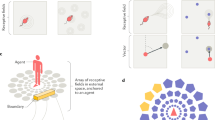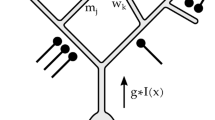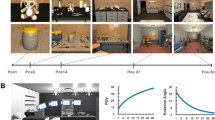Abstract
We argue that current theories of multisensory representations are inconsistent with the existence of a large proportion of multimodal neurons with gain fields and partially shifting receptive fields. Moreover, these theories do not fully resolve the recoding and statistical issues involved in multisensory integration. An alternative theory, which we have recently developed and review here, has important implications for the idea of 'frame of reference' in neural spatial representations. This theory is based on a neural architecture that combines basis functions and attractor dynamics. Basis function units are used to solve the recoding problem, whereas attractor dynamics are used for optimal statistical inferences. This architecture accounts for gain fields and partially shifting receptive fields, which emerge naturally as a result of the network connectivity and dynamics.
This is a preview of subscription content, access via your institution
Access options
Subscribe to this journal
Receive 12 print issues and online access
$189.00 per year
only $15.75 per issue
Buy this article
- Purchase on SpringerLink
- Instant access to full article PDF
Prices may be subject to local taxes which are calculated during checkout





Similar content being viewed by others
References
Spence, C. & Driver, J. Crossmodal Space and Crossmodal Attention (Oxford Univ. Press, Oxford, UK, in the press).
Yuille, A. L. & Bulthoff, H. H. in Perception as Bayesian Inference (eds Knill, D. C. & Richards, W.) 123–162 (Cambridge Univ. Press, New York, 1996).
Ernst, M. O. & Banks, M. S. Humans integrate visual and haptic information in a statistically optimal fashion. Nature 415, 429–433 (2002).
Deneve, S., Latham, P. & Pouget, A. Efficient computation and cue integration with noisy population codes. Nature Neurosci. 4, 826–831 (2001).
Pena, J. L. & Konishi, M. Auditory spatial receptive fields created by multiplication. Science 292, 249–252 (2001).
Gross, C. & Graziano, M. S. A. Multiple representations of space in the brain. Neuroscientist 1, 43–50 (1995).
Andersen, R. Multimodal integration for the representation of space in the posterior parietal cortex. Philos. Trans. R. Soc. Lond. B Biol Sci 352, 1421–1428 (1997).
Rizzolatti, G., Luppino, G. & Matelli, M. Organization of the cortical motor system: new concepts. Electroencephalogr. Clin. Neurophysiol. 106, 283–296 (1998).
Colby, C. & Goldberg, M. Space and attention in parietal cortex. Annu. Rev. Neurosci. 22, 319–349 (1999).
Jay, M. F. & Sparks, D. L. Sensorimotor integration in the primate superior colliculus. I. Motor convergence. J. Neurophysiol. 57, 22–34 (1987).
Duhamel, J., Bremmer, F., BenHamed, S. & Graf, W. Spatial invariance of visual receptive fields in parietal cortex neurons. Nature 389, 845–848 (1997).
Stricanne, B., Andersen, R. & Mazzoni, P. Eye-centered, head-centered, and intermediate coding of remembered sound locations in area LIP. J. Neurophysiol. 76, 2071–2076 (1996).
Cohen, Y. & Andersen, R. Reaches to sounds encoded in an eye-centered reference frame. Neuron 27, 647–652 (2000).
Buneo, C. A., Jarvis, M. R., Batista, A. P. & Andersen, R. A. Direct visuomotor transformations for reaching. Nature 416, 632–636 (2002).
Graziano, M., Hu, X. & Gross, C. Visuospatial properties of ventral premotor cortex. J. Neurophysiol. 77, 2268–2292 (1997).
Knill, D. C. Ideal observer perturbation analysis reveals human strategies for inferring surface orientation from texture. Vision Res. 38, 2635–2656 (1998).
Jacobs, R. A. & Fine, I. Experience-dependent integration of texture and motion cues to depth. Vision Res. 39, 4062–4075 (1999).
Anastasio, T. J., Patton, P. E. & Belkacem-Boussaid, K. Using Bayes' rule to model multisensory enhancement in the superior colliculus. Neural Comput. 12, 1165–1187 (2000).
Colonius, H. & Diederich, A. in Advances in Neural Information Processing Systems (eds Dietterich, T. G., Becker, S. & Ghahramani, Z.) (in the press).
Poggio, T. A theory of how the brain might work. Cold Spring Harb. Symp. Quant. Biol. 55, 899–910 (1990).
Pouget, A. & Sejnowski, T. A neural model of the cortical representation of egocentric distance. Cereb. Cortex 4, 314–329 (1994).
Pouget, A. & Sejnowski, T. Spatial transformations in the parietal cortex using basis functions. J. Cogn. Neurosci. 9, 222–237 (1997).
Pouget, A., Zhang, K., Deneve, S. & Latham, P. E. Statistically efficient estimation using population codes. Neural Comput. 10, 373–401 (1998).
Deneve, S., Latham, P. & Pouget, A. Reading population codes: a neural implementation of ideal observers. Nature Neurosci. 2, 740–745 (1999).
Ito, M. Neurophysiological aspects of the cerebellar motor control system. Int. J. Neurol. 7, 162–176 (1970).
Kawato, M., Furawaka, K. & Suzuki, R. A hierarchical neural-network model for control and learning of voluntary movement. Biol. Cybern. 57, 169–185 (1987).
Jordan, M. & Rumelhart, D. Forward models: supervised learning with a distal teacher. Cogn. Sci. 16, 307–354 (1992).
Pouget, A. & Snyder, L. Computational approaches to sensorimotor transformations. Nature Neurosci. 3, 1192–1198 (2000).
Zipser, D. & Andersen, R. A back-propagation programmed network that stimulates response properties of a subset of posterior parietal neurons. Nature 331, 679–684 (1988).
Burnod, Y. et al. Visuomotor transformations underlying arm movements toward visual targets: a neural network model of cerebral cortical operations. J. Neurosci. 12, 1435–1453 (1992).
Groh, J. & Sparks, D. Two models for transforming auditory signals from head-centered to eye-centered coordinates. Biol. Cybern. 67, 291–302 (1992).
Salinas, E. & Abbot, L. Transfer of coded information from sensory to motor networks. J. Neurosci. 15, 6461–6474 (1995).
Grossberg, S., Roberts, K., Aguilar, M. & Bullock, D. A neural model of multimodal adaptive saccadic eye movement control by superior colliculus. J. Neurosci. 17, 9706–9725 (1997).
Andersen, R., Essick, G. & Siegel, R. Encoding of spatial location by posterior parietal neurons. Science 230, 456–458 (1985).
Boussaoud, D., Barth, T. & Wise, S. Effects of gaze on apparent visual responses of frontal cortex neurons. Exp. Brain Res. 93, 423–434 (1993).
Trotter, Y. & Celebrini, S. Gaze direction controls response gain in primary visual-cortex neurons. Nature 398, 239–242 (1999).
Xing, J. & Andersen, R. A. Models of the posterior parietal cortex which perform multimodal integration and represent space in several coordinate frames. J. Cogn. Neurosci. 12, 601–614 (2000).
Robinson, D. A. Implications of neural networks for how we think about brain function. Behav. Brain Sci. 15, 644–655 (1992).
Driver, J. & Spence, C. Crossmodal links in spatial attention. Phil. Trans. R. Soc. Lond. B Biol. Sci. 353, 1319–1331 (1998).
Enright, J. The non-visual impact of eye orientation on eye–hand coordination. Vision Res. 35, 1611–1618 (1995).
Lewald, J. & Ehrenstein, W. The effect of eye position on auditory lateralization. Exp. Brain Res. 108, 473–485 (1996).
Henriques, D., Klier, E., Smith, M., Lowy, D. & Crawford, J. Gaze-centered remapping of remembered visual space in an open-loop pointing task. J. Neurosci. 18, 1583–1594 (1998).
Pouget, A., Ducom, J. C., Torri, J. & Bavelier, D. Multisensory spatial representations in eye-centered coordinates. Cognition 83, B1–B11 (2002).
Bertelson, P. in Cognitive Contributions to the Perception of Spatial and Temporal Events (eds Ashersleben, G., Bachmann, T. & Müsseler, J.) 347–362 (Elsevier, Amsterdam, 1999).
Author information
Authors and Affiliations
Corresponding author
Related links
Rights and permissions
About this article
Cite this article
Pouget, A., Deneve, S. & Duhamel, JR. A computational perspective on the neural basis of multisensory spatial representations. Nat Rev Neurosci 3, 741–747 (2002). https://doi.org/10.1038/nrn914
Issue Date:
DOI: https://doi.org/10.1038/nrn914
This article is cited by
-
Human brain representations of internally generated outcomes of approximate calculation revealed by ultra-high-field brain imaging
Nature Communications (2024)
-
Distributions of Visual Receptive Fields from Retinotopic to Craniotopic Coordinates in the Lateral Intraparietal Area and Frontal Eye Fields of the Macaque
Neuroscience Bulletin (2024)
-
Multisensory correlation computations in the human brain identified by a time-resolved encoding model
Nature Communications (2022)
-
Spatial coding for action across spatial scales
Nature Reviews Psychology (2022)
-
The Audio-Corsi: an acoustic virtual reality-based technological solution for evaluating audio-spatial memory abilities
Journal on Multimodal User Interfaces (2022)



